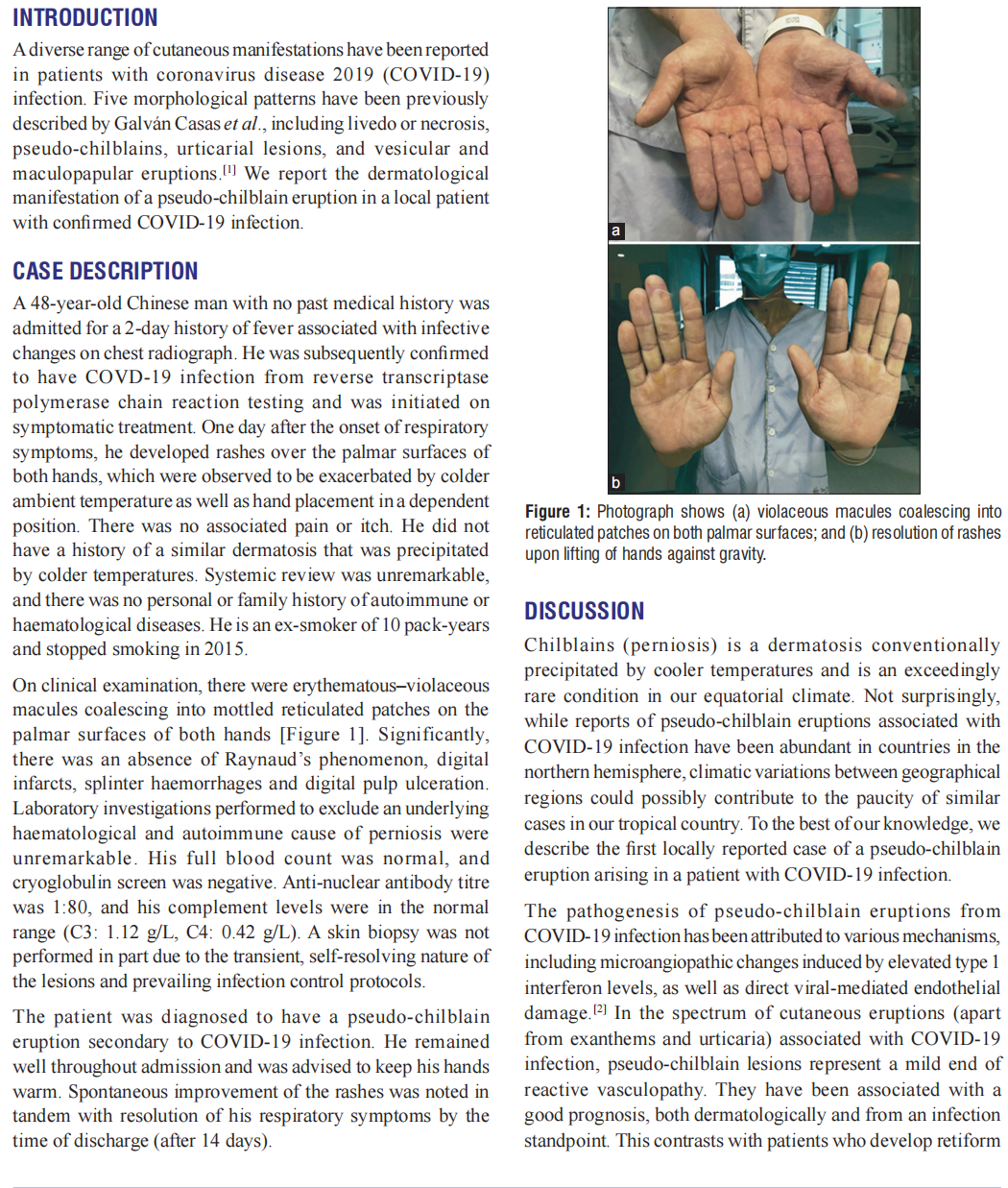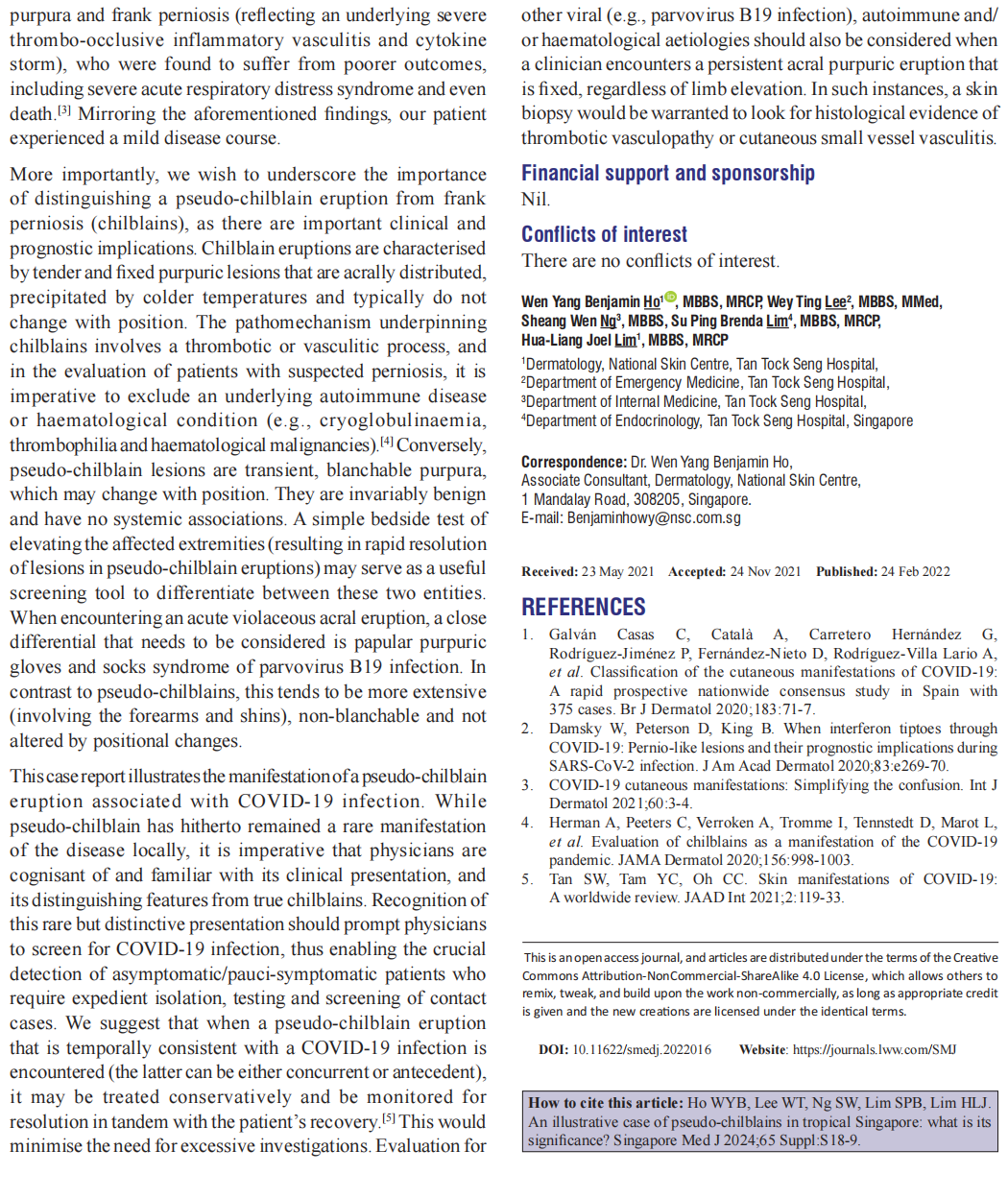文献精选


This article is excerpted from the Singapore Medical Journal ¦ Volume 65 ¦ Supplement 1 ¦ March 2024 by Wound World.
Shahad N Alanazi1 , Dana A Bali1 , Nawaf M Alwagdani2 , Youssof Mal3 , Maram T Alkhatieb4 , Hattan A AlJaaly1 , Zahir T Fadel1
1 Division of Plastic Surgery, Department of Surgery, Faculty of Medicine, King Abdulaziz University, Jeddah, Saudi Arabia; 2Department of Orthopedic Surgery, King Faisal Specialist Hospital and Research Centre, Riyadh, Saudi Arabia; 3Department of Clinical Biochemistry, Faculty of Medicine in Rabigh, King Abdulaziz University, Jeddah, Saudi Arabia; 4Department of Surgery, Faculty of Medicine, King Abdulaziz University, Jeddah, Saudi Arabia Received October 24, 2023; Accepted March 13, 2024; Epub April 15, 2024; Published April 30, 2024
Abstract: This case report describes a unique scenario in which antimycobacterial-induced peripheral neuropathy (PN) culminates in severe bilateral foot frostbite. Drug-induced peripheral neuropathy (DIPN) is explored in the context of TB treatment, highlighting the role of medications such as isoniazid (INH) and their potential to cause PN. The report highlights the importance of identifying PN in patients undergoing antimycobacterial treatment. Early recognition and proper management of PN is crucial to prevent complications. Notably, the report advocates for patient education regarding medication side effects and avoiding harmful practices, such as ice immersion, to alliviate neuropathic pain. Emphasis is directed towards the need for a multidisciplinary approach to patient care and a focus on preventative strategies to improve patient outcomes and avoid severe debilitating complications.
Keywords: Frostbite, peripheral neuropathy, isoniazid (INH), drug-induced peripheral neuropathy (DIPN)
Fulin Li1† , Yingrong Mo2† , Xiao Huang1 , Ke Sun1 , Baichuan Li1 and Dong Yin1 *
1 Department of Joint Surgery and Sports Medicine, The People's Hospital of Guangxi Zhuang Autonomous Region, Guangxi Academy of Medical Sciences, Nanning, China, 2Department of Pharmacy, The People's Hospital of Guangxi Zhuang Autonomous Region, Guangxi Academy of Medical Sciences, Nanning, China
EDITED BY
Philip M. Gallagher,
University of Kansas, United States
REVIEWED BY
Elisa Belluzzi, University of Padua, Italy Jianlin Shen, Affiliated Hospital of Putian University, China
*CORRESPONDENCE
Dong Yin 该Email地址已收到反垃圾邮件插件保护。要显示它您需要在浏览器中启用JavaScript。
† These authors have contributed equally to this work
RECEIVED 01 February 2024
ACCEPTED 12 April 2024
PUBLISHED 29 April 2024
CITATION
Li F, Mo Y, Huang X, Sun K, Li B and Yin D (2024) Cyclic cryotherapy with vitamin D facilitates early rehabilitation after total knee arthroplasty.
Front. Med. 11:1380128.
doi: 10.3389/fmed.2024.1380128
COPYRIGHT
© 2024 Li, Mo, Huang, Sun, Li and Yin. This is an open-access article distributed under the terms of the Creative Commons Attribution License (CC BY). The use, distribution or reproduction in other forums is permitted, provided the original author(s) and the copyright owner(s) are credited and that the original publication in this journal is cited, in accordance with accepted academic practice. No use, distribution or reproduction is permitted which does not comply with these terms.
Objective: This study aimed to evaluate the efficacy of cyclic cryotherapy and vitamin D administration on early rehabilitation after total knee arthroplasty (TKA), as its efficacy remains unclear.
Methods: We divided 150 patients (three groups) who underwent TKA into those treated with or without cyclic cryotherapy and vitamin D.
Results: Compared with patients who did not receive cyclic cryotherapy, those who received postoperative cyclic cryotherapy and vitamin D supplementation had significantly higher American Knee Society Scores (AKSS) on postoperative day (POD) 7 and at 1 month postoperatively; higher visual analogue scale (VAS) values on POD1–3 and POD7; reduced thigh swelling on POD3 and POD7; increased range of motion (ROM) on POD3, POD7, and at 1 month postoperatively; and reduced postoperative length of stay (PLOS). However, no significant difference in patient satisfaction was observed between the patient groups. At 1 and 3 months postoperatively, patients administered cyclic cryotherapy and vitamin D had significantly higher AKSS, ROM, and vitamin D levels than those who did not receive vitamin D. No perioperative complications such as surgical site infection, skin frostbite, or vitamin D intoxication were
Conclusion: Cyclic cryotherapy post-TKA had short-term advantages in terms of AKSS, VAS, thigh swelling, ROM, PLOS, and accelerated rehabilitation, but did not improve patient satisfaction. Cyclic cryotherapy combined with vitamin D improved AKSS and ROM at 1 and 3 months postoperatively.
KEYWORDS
vitamin D, cyclic cryotherapy, total knee arthroplasty, rehabilitation, satisfaction
Sitong Wang1 , Xueyu Li2*, Yuli Fang2 , Qin Shu3 , Ruihang Ma1 and Di Wu2
Abstract
Background One of the challenges of physical training in extreme condition is frostbite, especially in Northeast China. In this study, we aimed to construct a risk prediction model for frostbite among soldiers in Northeast China, and verify its effect.
Methods 698 participants were selected via convenience sampling from Northeast China from December 2021 to January 2022 (winter). They were randomly divided into a training set (N=479) and a testing set (N=202) in a ratio of 7:3. All participants completed a researcher-made questionnaire on frostbite. The prediction model was constructed through the use of Logistic regression analysis, which was used to predict the independent risk factors for frostbite formation and screen significant indicators. The model’s performance was assessed using the receiver operating characteristic (ROC) curve and decision curve analysis (DCA) to evaluate the prediction efficiency and goodness of fit.
Results The incidence of frostbite in the training set was 19.83% (95 people), all of which were first-degree frostbite. Among them, frostbite in multiple parts was the most common (58.95%), followed by singular body parts like hands (24.21%), ears (11.58%) and feet (5.26%). Single factor logistic regression analyses showed that ambient temperature, ambient wind speed, outdoor stationary time, stationary status, and history of frostbite are independent risk factors that affect the occurrence of frostbite. Furthermore, we constructed the frostbite risk prediction model for soldiers in the northeastern region of China. The area under the receiver operating characteristic curve (AUC) for the risk of frostbite in the training set and testing set was 0.816 (95% CI, 0.770~0.862) and 0.787 (95% CI, 0.713~0.860), respectively. The Hosmer-Lemeshow test of the model showed χ 2=11.328 and P=0.184 (>0.05). The DCA curve indicated that most of the clinical net benefits of the model are greater than 0, demonstrating good clinical
Conclusion The constructed frostbite prediction model can effectively identify soldiers with a higher risk of frostbite. It provided theoretical support for commanders to take preventive measures to reduce the incidence of frostbite among soldiers and was of great clinical guiding significance.
Keywords Frostbite, China, Northeast region, Influencing factors, Prediction model
*Correspondence:
Xueyu Li
该Email地址已收到反垃圾邮件插件保护。要显示它您需要在浏览器中启用JavaScript。
1 Department of Emergency Medicine, General Hospital of Northern Theater Command, Shenyang, Liaoning 110016, People’s Republic of China
2 Department of Nursing, General Hospital of Northern Theater Command, Wenhua Road 83rd Shenhe Region, Shenyang, Liaoning 110016, People’s Republic of China
3 School of Nursing, Army Medical University, Chongqing 400038, People’s Republic of China
© The Author(s) 2024. Open Access This article is licensed under a Creative Commons Attribution-NonCommercial-NoDerivatives 4.0 International License, which permits any non-commercial use, sharing, distribution and reproduction in any medium or format, as long as you give appropriate credit to the original author(s) and the source, provide a link to the Creative Commons licence, and indicate if you modified the licensed material. You do not have permission under this licence to share adapted material derived from this article or parts of it. The images or other third party material in this article are included in the article’s Creative Commons licence, unless indicated otherwise in a credit line to the material. If material is not included in the article’s Creative Commons licence and your intended use is not permitted by statutory regulation or exceeds the permitted use, you will need to obtain permission directly from the copyright holder. To view a copy of this licence, visit http:// creativecommons.org/licenses/by-nc-nd/4.0/.




